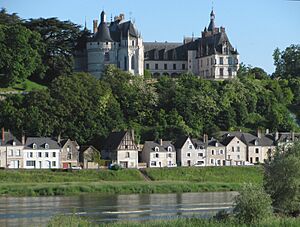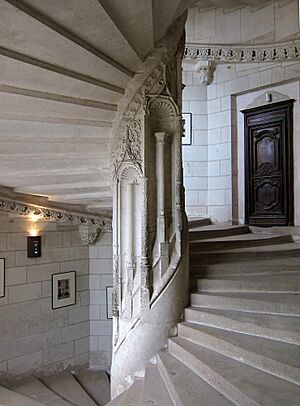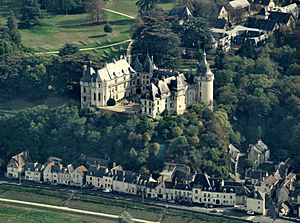Château de Chaumont facts for kids
The Château de Chaumont, also known as Château de Chaumont-sur-Loire, is a beautiful castle in Chaumont-sur-Loire, France. A castle is called a château in French. This amazing building was first built way back in the 10th century. It was started by a powerful leader named Odo I, Count of Blois.
Over time, the castle faced many challenges. It was even ordered to be destroyed by King Louis XI! But it was rebuilt in the 15th century. Today, the Château de Chaumont is a special place. It has been protected as a monument historique (a historic monument) since 1840. Since 1938, it has belonged to the French government and is open for everyone to visit.
Contents
Exploring Chaumont Castle's Past
The name Chaumont comes from French words meaning "bald hill." This makes sense because the castle sits high up on a hill. The very first castle here was built in the 10th century. It was located between two important towns, Blois and Amboise.
Why Was the First Castle Built?
The first castle was built by Odo I, Count of Blois. He wanted to protect his lands from attacks. His main rival was Fulk Nerra, Count of Anjou. A Norman knight named Gelduin was given the castle. He made it stronger and kept it safe. Later, through family connections, the castle became part of the Amboise family for about 500 years.
The Castle's Destruction and Rebuilding
In 1465, a man named Pierre d'Amboise went against King Louis XI. Because of this, the king took away Pierre's property. He even ordered the castle to be taken apart!
But the castle was not gone for good. Charles I d'Amboise rebuilt it between 1465 and 1475. His son, Charles II d'Amboise, finished the work from 1498 to 1510. They added some new Renaissance style features. However, the castle still looked mostly like a medieval fortress.
Famous Owners and Their Stories
Catherine de Medici and Diane de Poitiers
In 1550, Catherine de Medici bought the château. She was a very powerful queen of France. She even invited astrologers, like Nostradamus, to visit her there.
When her husband, King Henry II, died in 1559, Catherine made a deal. She forced Henry's mistress, Diane de Poitiers, to trade castles. Diane had to give up the beautiful Château de Chenonceau. In return, she received the Château de Chaumont. However, Diane de Poitiers only lived at Chaumont for a short time.
Later Owners and Changes
After Diane's granddaughter passed away in 1594, the castle was sold. It was bought by a tax collector who had become very rich. He was later arrested, and the castle changed hands again.
In 1699, Paul de Beauvilliers bought the château. He updated some of the rooms inside. He made it grand enough to host important guests, like the Duke of Anjou. The duke was on his way to become the king of Spain. Later, a new owner, Monsieur Bertin, made a big change. He removed the north wing of the castle. This opened up the view towards the river, which was a popular style at the time.
An American Revolution Supporter
In 1750, Jacques-Donatien Le Ray bought the castle. He used it as a country home and started a glass and pottery factory there. He was known as a "Father of the American Revolution" in France because he supported America. But during the French Revolution in 1789, the new government took away his property, including the Château de Chaumont.
Madame de Staël and Modern Times
Madame de Staël, a famous writer, bought the château in 1810. Later, in 1833, the Comte d'Aramon bought the castle. It had been neglected, so he started many repairs. He even created a museum of medieval art inside one of the towers.
In 1875, Marie-Charlotte Say bought Chaumont. She was very wealthy. She married Prince Henri Amédée de Broglie later that year. The Prince built amazing stables in 1877. He also continued to restore the château and redesigned the park around it. He made it look like an English naturalistic landscape.
Marie-Charlotte Say gave the Château de Chaumont to the French government in 1938. Today, it is a museum. Every year, from April to October, it hosts a special Garden Festival. Here, modern garden designers show off their creative work in the beautiful English-style garden.
Gallery
-
Coat of arms of Louis XII
See also
 In Spanish: Castillo de Chaumont para niños
In Spanish: Castillo de Chaumont para niños
- List of castles in France












